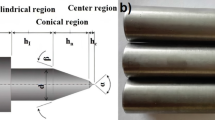Abstract
In this study, the surface roughness, dimensional accuracy, and circular and cylindrical deviations characterizing the hole quality were investigated experimentally. AISI 1050 steel in experiments was chosen as reference material due to its extensive applications in many areas. Uncoated and TiAlN coated by physical vapor deposition (PVD) method HSS twist drills with different diameters were used. Experiments were conducted on a CNC vertical machining center under dry condition with different cutting speeds and feed rates. The hole depth was 17 mm to ensure L < 3D condition. After each experiment, hole properties such as surface roughness, dimensional accuracy, circular deviation, and axial misalignment between inlet and outlet holes (cylindrical deviation), all of those that show the hole quality, were measured, and the results were evaluated. In addition to experimental analysis, a statistical analysis was carried out to indicate the effects of drilling parameters on test results. Process parameters such as tool type, drill diameter, feed rate, and cutting speed were optimized with consideration of multiple performance characteristics using desirability functional analysis. As a result, coated tools compared with uncoated tools gave positive results for each evaluation criterion. As the most important parameter on surface roughness (Ra) was drill diameter, the most effective parameter on dimensional accuracy, and circular and cylindrical deviations was cutting speed for both uncoated and coated tools except from cylindrical deviation occurring in uncoated drill.
Similar content being viewed by others
References
Tonshoff H.L., Spintig W., Konig W., Neises A.: Machining of holes developments in drilling technology. Ann. CIRP 43(2), 551–560 (1994)
Dinc C., Lazoglu I., Serpenguzel A.: Analysis of thermal fields in orthogonal machining with infrared imaging. J. Mater. Process. Technol. 198, 147–154 (2008)
Soylu, A.: Investigation of thrust force and torque in couple of tool-work piece (HSS-Ç1040) by the design and manufacturing of drilling dynamometer. Dissertation, Selçuk University, The Institute of Science and Technology (2007)
Kelly J.F., Cotterell M.G.: Minimal lubrication machining of aluminium alloys. J. Mater. Process. Technol. 120, 327–334 (2002)
Strenkowski J.S.: An analytical finite element technique for predicting thrust force and torque in drilling. Int. J. Mach. Tools Manuf. 44, 1413–1421 (2004)
Armerago E.J.A., Cheng O.Y.: Drilling with flat face and canventional twist drill-II. Experimental investigation. Int. J. Mach. Tool Des. Res. 12, 37–54 (1972)
Kaynak, Y.: An experimental study of the investigation of the cutting parameter’s effects on the cutting force and the temperature in drilling. Dissertation, Marmara University, The Institute of Science and Technology (2006)
Küçüktürk G.: Modeling and analyzing the effects of experimentally determined torque and thrust force on cutting tool according to drilling parameters. Proc. Inst. Mech. Eng. B J. Eng. Manuf. 227(1), 84–95 (2013)
Bono M.: The location of the maximum temperature on the cutting edges of a drill. Int. J. Mach. Tools Manuf. 46, 901–907 (2006)
Kıvak T., Samtaş G., Çiçek A.: Taguchi method based optimisation of drilling parameters in drilling of AISI 316 steel with PVD monolayer and multilayer coated HSS drills. Measurement 45(6), 1547–1557 (2012)
Incal, E.: Investigation of characterisation and wear resistance of HSS tool steel coated by PVD method. Dissertation, Yıldız Technical University, The Institute of Science and Technology (2007)
Tosun G.: The drilling of an Al/SiCp metal-matrix composites. Part I: microstructure. Compos. Sci. Technol. 64, 299–308 (2004)
Cheung F.Y., Zhou Z.F., Gedam A., Li K.Y.: Cutting edge preparation using magnetic polishing and its influence on the performance of high-speed steel drills. J. Mater. Process. Technol. 208, 196–204 (2008)
Haggrty W.A.: Effect of point geometry and dimensional symmetry on drill performance. Int. J. Mach. Tool Des. Res. 1, 41–58 (1961)
Akkurt, M.: Machining Methods and Machine Tools. Birsen Publishing House, 23-9, İstanbul, Turkey (1998)
Michael F., Kahles J.F., Koster W.P.: ASM handbook: surface finish and surface integrity. Am. Soc. Metals 3, 468–475 (1989)
Gunay, M.: Investigation of the mechanics and machinability properties of Al−Si/SiC p composites produced by powder metallurgy. Dissertation, Gazi University The Institute of Science and Technology (2009)
Coromant, S.: Cutting Tool Hand Guide, Sweden (2008)
Coromant, S.: Modern Metal Cutting, 2-61, Sweden (1994)
Mendi, F.: Machine Tools Theory and Calculations. ISBN 975-96008, 5-40 (1996)
Sarıkaya, M.; Yılmaz, V.; Dilipak, H.: Modeling and multi-response optimization of milling characteristics based on Taguchi and gray relational analysis. Proc. IMechE B J. Eng. Manuf. (2015). doi:10.1177/0954405414565136
Kıvak T.: Optimization of surface roughness and flank wear using the Taguchi method in milling of Hadfield steel with PVD and CVD coated inserts. Measurement 50, 19–28 (2014)
Sarıkaya M., Güllü A.: Taguchi design and response surface methodology based analysis of machining parameters in CNC turning under MQL. J. Clean. Prod. 65, 604–616 (2014)
Sarıkaya M., Güllü A.: Multi-response optimization of MQL parameters using Taguchi-based GRA in turning of difficult-to-cut alloy Haynes 25. J. Clean. Prod. 91, 347–357 (2015)
Sait A.N., Aravindan S., Haq A.N.: Optimization of machining parameters of glass–fibre-reinforce plastics analysis using Taguchi technique. Int. J. Adv. Manuf. Technol. 43, 581–589 (2009)
Ezilarasan C., Kumar V.S.S., Velayudham A.: An experimental analysis and measurement of process performances in machining of nimonic C-263 super alloy. Measurement 46, 185–199 (2013)
Author information
Authors and Affiliations
Corresponding author
Rights and permissions
About this article
Cite this article
Meral, G., Sarıkaya, M., Dilipak, H. et al. Multi-response Optimization of Cutting Parameters for Hole Quality in Drilling of AISI 1050 Steel. Arab J Sci Eng 40, 3709–3722 (2015). https://doi.org/10.1007/s13369-015-1854-z
Received:
Accepted:
Published:
Issue Date:
DOI: https://doi.org/10.1007/s13369-015-1854-z



